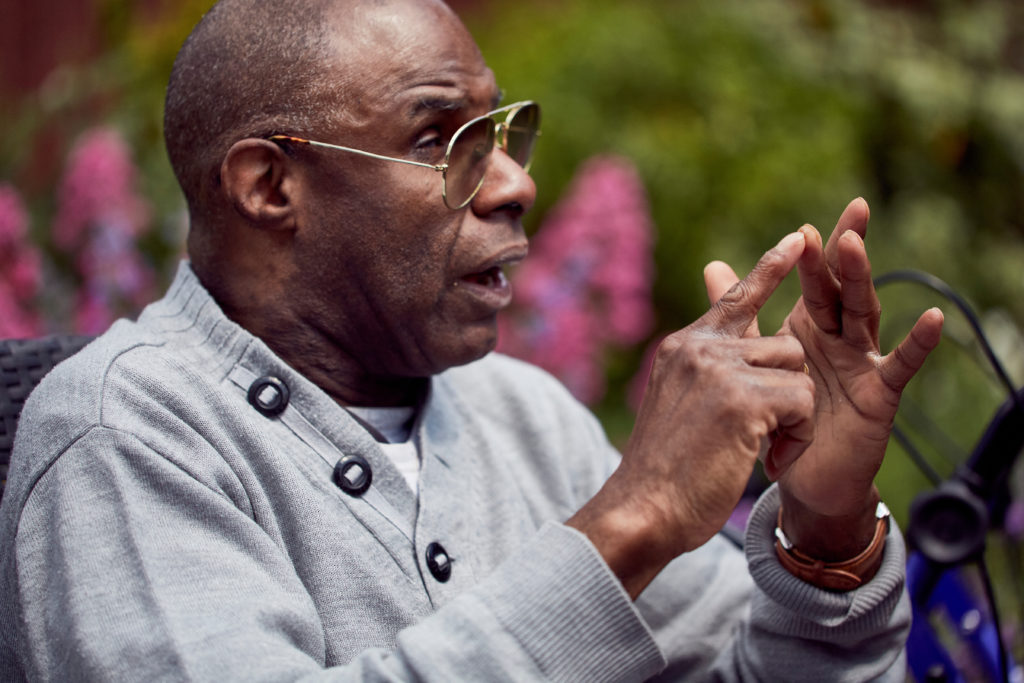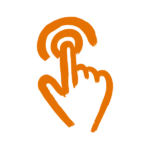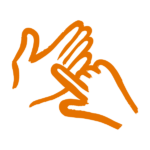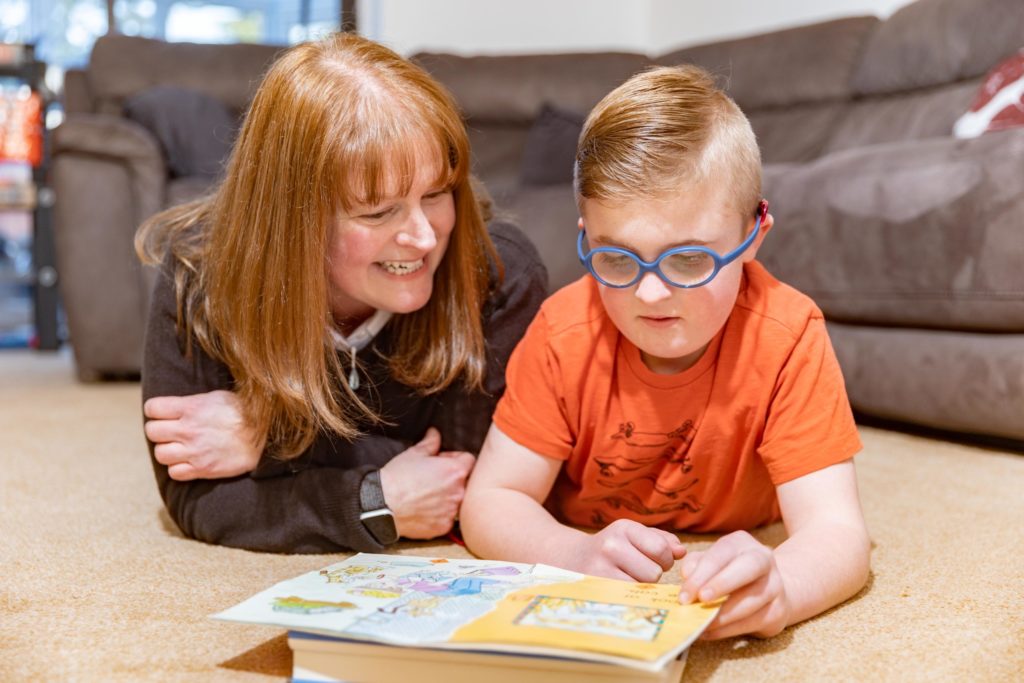Sign language
This page explains the basics of sign language, including how it works, who uses it and how to learn it.
Find out more about British Sign Language, and other forms of signing like Makaton.
- What is sign language?
- Benefits of sign language
- British Sign Language (BSL)
- Other types of sign language
Before you read on…
- You can communicate using a mix of different ways (we all do!).
- At Sense, we use whatever combination of speech, touch, sign or visual language works best.
- It’s never too late to start.
- Have a go and don’t worry about getting it wrong.
- If you want to learn more about BSL, check out Sense Sign School.

What is sign language?
Sign language is a way of communicating using hand gestures and movements, body language and facial expressions, instead of spoken words.
The most common form of sign language in the UK is British Sign Language (BSL). BSL is a language in its own right.
Sign language is used mainly by people who are D/deaf or have hearing impairments.
Some people describe themselves as “Deaf” with a capital “D” to express pride in their Deaf identity.
Find out more about D/deafness and hearing loss.
Some forms of sign language are also used by people with other communication and learning needs, and babies who haven’t yet started speaking.
When was sign language invented?
Historians believe that sign language is probably older than spoken language.
The first evidence of people using hand signs and gestures to communicate dates all the way back to the fifth century.
Formally, the history of sign language in Western societies begins around the 17th century.
Find out more about the history of British Sign Language.
Who invented sign language?
Sign language was created by many people around the world.
This is because different sign languages developed independently around the world at different times. They were mostly created by D/deaf people as a way of communicating with their communities.
Some forms of sign language were also created by monks who had taken a vow of silence.
Is sign language universal?
Like any spoken language, such as Italian or Spanish, sign language varies across countries. There are lots of different sign languages across the world.
In the UK, “sign language” usually refers to British Sign Language (BSL).
There are also differences within sign languages, in the same way that there are regional differences in the way people speak English around the UK.
For example, the word “green” is generally signed differently in Bristol than it is in Newcastle.
Try using sign language!
View the complete sign language alphabet
A

B

C

D

E

F

G

H

I

J

K

L

M

N

O

P

Q

R

S

T

U

V

W

X

Y

Z

Benefits of sign language
- Communication. Of course, the biggest benefit of sign language is that it’s a crucial way for many D/deaf people to communicate and build relationships. The more people who can use sign language, the more inclusive society can be.
- Expression. Signing is not just about hand gestures, but facial expressions and body language, too! Learning how to sign can make you more expressive.
- Creativity. Sign language is an imaginative language, and learning how to use it can open up new ways to express yourself and create meaning.
British Sign Language (BSL)
BSL is the most common sign language in the UK.
In Northern Ireland, Irish Sign Language (ISL) is used as well as BSL. Find out more about ISL on the Irish Deaf Society website.
BSL, like all sign language, is more than hand shapes and movements. Lip patterns, facial expressions and shoulder movements are important, and when used well, really enhance meaning.
It is a complete language, with its own vocabulary, grammar and word order, as well as its own social beliefs, behaviours, art, history and values.
How BSL syntax differs from English
In BSL, you start with the main subject or topic. Then, you say something about it.
So, for example, in English, you say:
Q: “What is your name?”
A: “My name is George.”
But in BSL, you say:
Q: “Name – what?”
A: “Name me George.”
Watch someone using British Sign Language
Watch George using BSL and fingerspelling.
Audio described version of Say Hello to George with transcript.
The history of BSL
The earliest documented use of sign language in the UK was in 1576. Church records from St Martin’s Church in Leicester show that sign language was used in a marriage ceremony between two people named Thomas Tilsye and Ursula Russel.
But although D/deaf people used sign language all around the country, up until around the 1970s signing wasn’t encouraged. Many D/deaf children were taught with an emphasis on spoken and written language.
The Deaf academic, writer and activist Paddy Ladd is often credited as helping to boost the profile of BSL. He hosted a programme called See Hear using speech and sign on the BBC in the 1980s.
In 2003, the government made a formal statement acknowledging that BSL is a language in its own right.
British Sign Language Act 2022
In 2021, the British Deaf Association launched a campaign called BSL Act Now, to get BSL legally recognised as an official language of England, Wales and Scotland.
The BSL Act was introduced to the House of Commons by Labour MP Rosie Cooper, and supported by thousands of people at a rally in Trafalgar Square.
The BSL Act 2022 became law in Spring 2022.
How many people use BSL as their main language?
BSL is the language of the Deaf community in the UK, who use a capital D to express pride in their identity.
For over 87,000 British Deaf people, BSL is their first language. English may be their second or even third language.
It’s estimated that BSL is used by around 125,000 adults and 20,000 children in total.
BSL interpreters enable communication between D/deaf sign language users and hearing people.
BSL interpreters
If you need to book an interpreter, check they are registered with either:
- National Registers of Communication Professionals working with Deaf and Deafblind People (NRCPD)
- Scottish Association of Sign Language Interpreters (SASLI)
Tips for hearing people using BSL interpreters
It is important to remember that the interpreter is not just interpreting for the D/deaf person. They are also interpreting for the hearing person.
Interpreters should be positioned in a place where D/deaf people can easily see them and also see the person they are talking to.
If you are a hearing person speaking to a D/deaf person via an interpreter, keep looking at the D/deaf person while you speak. Address the person directly, as you would talk to a hearing person.
For example, don’t say “Can you tell him…”
Speak at your normal speed and volume.
“It was such a rewarding moment when Sam signed ‘more’ to get extra time on the swing. We’d been immersing Sam in sign language for months and months, by signing our conversations so he got used to language. Finally, he started using it himself!”
Sarah Turpin, senior MSI practitioner for Sense
How to learn BSL
Learning BSL is like learning any other language. People who grow up using BSL as their first language learn by being immersed in a signing environment as children.
If you’d like to learn BSL as a second or third language, you can learn in person by signing up to a course with a qualified BSL teacher. You’ll start with the basics and work your way up.
The pace is up to you. You can learn part-time, in the evening, or if you want to learn quicker, you can find intensive courses with daytime or weekend classes.
The best way to develop your signing skills is to practice as much as you can. Spend time with D/deaf people, and in the Deaf community, as much as possible.
You can often learn in local colleges, universities, schools, Deaf clubs and community centres. Find your nearest BSL course by visiting Signature.
Signature
Signature is a national charity and the leading awarding body for D/deaf communication qualifications in the UK.
All Signature qualifications are nationally recognised and accredited by Ofqual.
With almost 40 years’ experience, Signature has supported more than 450,000 people to learn BSL.
Signature’s work, courses and qualifications.
4 top tips for learning BSL
- Learn the BSL fingerspelling alphabet. They’re quick to learn and an easy way to get started. Practise every day for 10 minutes and you’ll pick them up in no time.
- Facial expressions are key! You use them to show the mood of the conversation or topic.
- Don’t be afraid to be expressive. Want to show “it’s raining heavily” or “it’s really windy”? Show it in your facial expression and sign “rain” or “wind” more strongly with your hand movement.
- Teach a friend. Teaching someone else as you learn is one of the best ways of remembering what you’ve learnt.
Other types of sign language
Fingerspelling
Fingerspelling is the BSL alphabet. Every letter of the alphabet has a sign.
You can use these letter signs to spell out words – often names and places – and sentences on your hand.
Fingerspelling is an easy way to communicate if you don’t know or can’t remember some BSL signs.
Hands-on BSL
If you are D/deaf and also have a visual impairment that means you can’t see signing at a distance, you can use hands-on BSL.
With hands-on BSL, you and the person you’re communicating with use the BSL signs on each other’s hands, not on your own.
Watch someone using hands-on BSL
Watch Helene using hands-on signing as one of the ways she communicates. She also explains how you can say “hello” using block, another fingerspelling alphabet.
Audio described version of Say Hello to Helene with transcript.
Sign Supported English (SSE)
Sign Supported English (SSE) is a term used to describe signing and speaking English at the same time.
Often, SSE borrows BSL signs and uses them in the order they are used in spoken English.
BSL is a unique language, with its own word order and syntax. But SSE generally follows the same grammatical rules as English.
You can’t learn SSE. It’s not a language in the same way that BSL is. But communicating with SSE can be helpful in some circumstances (for example, if you’re learning BSL).
Makaton
Makaton is a simplified way of signing. It’s sometimes called “key word signing”.
It’s not a formal sign language.
Differences between Makaton and BSL
- BSL is an officially recognised language. Makaton is not.
- BSL is the language of the Deaf community. Makaton is a form of signing mostly used by hearing people who have learning disabilities, autism or different communication needs.
- In Makaton, words are used in spoken word order. BSL has its own syntax and word order that is different to spoken language.
Other types of communication
These are the main ways of communicating that we use:
-

Using touch
- Braille uses raised dots to touch.
- Deafblind Manual spells words on to your hand.
- Block alphabet spells letters on to your hand.
- Moon uses raised lines, curves and dots to touch.
- Tadoma uses lipreading by touch.
- Hand-under-hand signing using touch.
-

Using signs
- Makaton, a simpler version of sign language.
- Visual frame signing for people with reduced vision.
- Objects of reference
-

Using speech
-

Also
- Non-formal communication without speaking, writing or signing.
- Intensive interaction treating everything as communication.
Stay in touch

Get updates about our vital work, including volunteering, making a donation or supporting Sense campaigns.
This content was last reviewed in January 2023. We’ll review it again in 2025.

